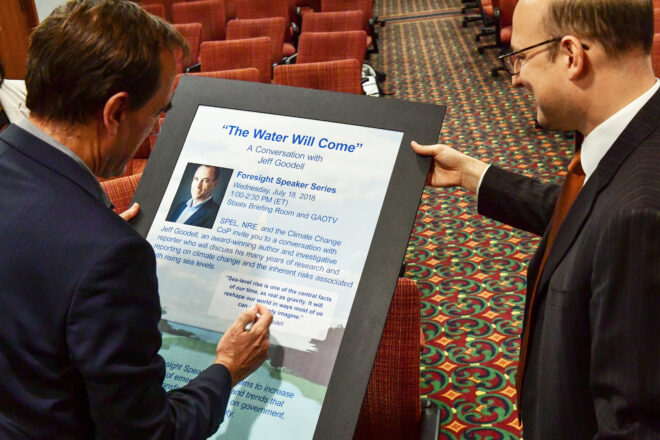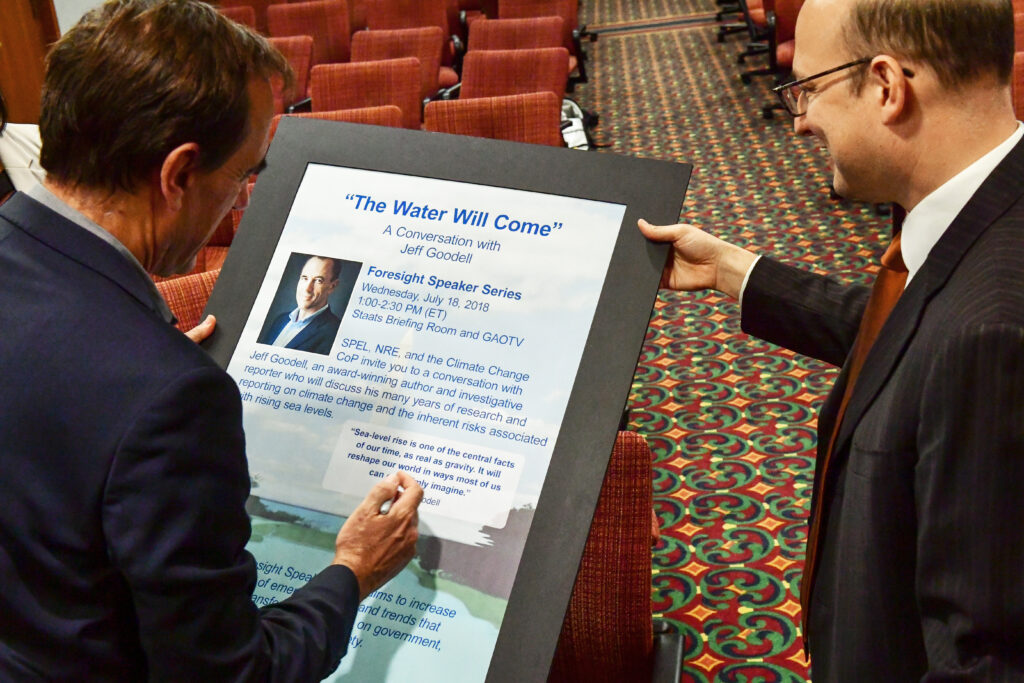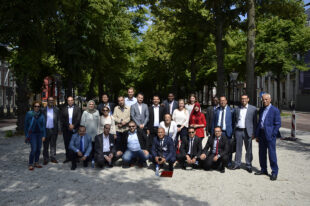The Water Will Come: A Conversation with Prominent Climate Change Expert

by David Chrisinger, Strategic Planning and External Liaison Office, U.S. Government Accountability Office

“It’s a done deal. We are going to get a significant amount of sea level rise.”
Jeff Goodell does not mince words.
“Sea-level rise is one of the central facts of our time, as real as gravity. It will reshape our world in ways most of us can only dimly imagine,” he said.
The author of five books, Goodell is a prominent expert on climate change, energy policy and humanity’s relationship with a changing planet. For the past several years, he has traveled the globe, researching, reporting on and writing about the impending crisis of rising sea levels.
The U.S. Government Accountability Office (GAO), the Supreme Audit Institution (SAI) for the United States, hosted Goodell as part of GAO’s Foresight Speaker Series. The speaker series, managed by GAO’s Strategic Planning and External Liaison (SPEL) office, aims to increase awareness of emerging issues and trends having transformative effects on government, business and society.
“Rising sea level is an issue that could impact nearly every audit team’s work at GAO,” remarked Steve Sanford, GAO’s Strategic Planning and Innovation Manager, who moderated the discussion.
Sanford added, “Not only are there implications for flood insurance programs in the United States, but rising sea levels will also affect how the U.S. federal government manages government real property and housing finance, maintains the nation’s surface transportation system, and manages the government’s fiscal exposure to climate change risks.”
Goodell’s interest in rising sea levels began soon after Hurricane Sandy flooded the Lower Manhattan neighborhood of New York City with 9 feet of water in the fall of 2012. He began speaking with a Columbia University scientist who told him the storm was a dress rehearsal of sorts for what most scientists were predicting would happen by the end of the century—that the sea around Manhattan would rise about 9 feet (some say sea levels may rise 30 feet or more). Instead of eventually receding, the water from sea level rise will stick around.
From there, Goodell traveled to Miami, where he found a city hugely at risk—due to south Florida’s flatness and the porous limestone beneath the city’s buildings—of becoming an “American Atlantis.”
After spending the next few years traveling all over the world, Goodell found that rising sea levels have serious implications for coastal regions around the globe.
“This is a problem of human infrastructure. We simply built in areas we should not have built in,” Goodell told event participants.
He explained that “the ocean acts like a kind of heat sink. The heat has to go somewhere, and it’s going into the ocean the same way as if you leave a glass of water out on a hot day. That water gets hot.”
Thermal expansion, in part, is the cause of sea level rise in the 20th century. As the ocean heats up, it expands.
“But that is going to be an increasingly small part of the problem of sea level rise in the future,” Goodell noted.
“It’s really all about the two big sheets of ice at the poles. What matters is how fast Greenland melts and what happens in Antarctica. Those are the two driving factors that will shape our future.”
What’s surprising to scientists today, Goodell went on to say, is that until about 10 years ago, they thought that Antarctica’s ice was pretty stable; there wasn’t nearly as much surface ice melting there as there was in Greenland. Scientists now believe the biggest factor driving ice melt is not surface melt, but rather melting from below by warm ocean water.
When asked whether there are any U.S. states or countries that are taking the right steps to address the crisis of rising sea levels, Goodell mentioned several places that have plans to do something, though in terms of action, he says it’s a hard problem to solve.
“Sea walls won’t work in places like south Florida,” he noted, “because the water will simply seep under the walls.”
By contrast, when Goodell visited places like Lagos, “where they build their homes on posts,” he said, “they say they can raise their homes 4 feet in an afternoon…you cannot do that as easily in Miami Beach.”
He also detailed an ambitious—and very expensive—solution put forth by the Italian city of Venice. The $6 billion project consists of four retractable gates paired with 57 flood barriers that can be raised at high tide to protect the canal-laden city. The problem, Goodell cited, is that the engineers who developed the barriers did not account for rising sea levels, so eventually the barriers will no longer be enough to keep the water out.
“It’s a great example of really dumb engineering that looks smart…and I think there’s going to be a lot of projects like that,” he remarked.
Goodell said that, ultimately, some combination of retreat from coastal regions, paired with engineering that allows for flexible construction and adaptation, is what policy makers should be focusing on in response to rising sea levels.
“We’re going to have to reinvent our relationship to water. There’s just not enough money to save these places.”
Goodell also indicated a big, near-term risk. Coastal properties will devalue as people begin to understand that flooding will no longer be a once a year or once every decade occurrence. Rising sea levels will, in other words, change the economic value of coastal and low-lying properties. He said it’s this point (the economic impact of rising sea levels) that may be the best way to draw attention to the need to take meaningful action.
GAO has performance audits under way to evaluate potential climate change effects on migration within the United States and the resilience of water infrastructure, among other engagements. GAO is also in the process of updating its high-risk area, “Limiting the Federal Government’s Fiscal Exposure by Better Managing Climate Change Risks.”1
Goodell said what is most needed now is engagement and political dialogue to chart a way forward.
He summed up that before policy makers can effectively address rising sea levels, and before the country learns to change its relationship to coastal areas, there must first be recognition that rising sea levels are, in Goodell’s words, “a real threat to our future.”
1 For more information on GAO’s High Risk List, which brings attention to agencies and program areas GAO believes are high risk due to their vulnerabilities to fraud, waste, abuse, and mismanagement, or are most in need of transformation, see https://www.gao.gov/highrisk/overview.





